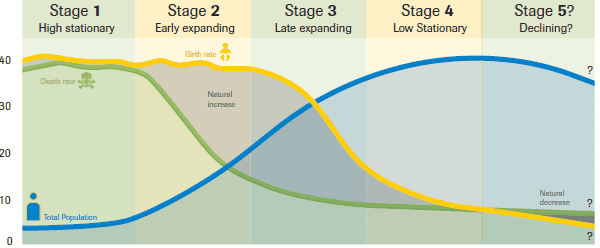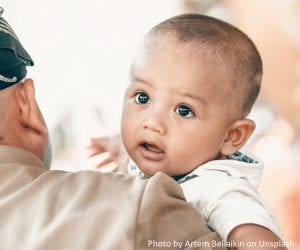This is post 1 of 6 in a series about the Demographic Transition Model – a fundamental concept in population education, which is covered in Social Studies courses, most notably AP Human Geography.
Beginning in the late 1700s, something remarkable happened: death rates declined. With new technologies in agriculture and production, and advancements in health and sanitation, a greater number of people lived through their adolescent years, increasing the average life expectancy and creating a new trajectory for population growth. This sudden change created a shift in understanding the correlation between birth and death rates, which up to that point had both been relatively equal, regardless of location. Over the past 300 years, population demographics have continued to evolve as a result of the relationship between the birth and death rates within a country. The observation and documentation of this global phenomenon has produced a model, the Demographic Transition Model, which helps explain and make sense of changes in population demographics. Using the Demographic Transition Model, demographers can better understand a country’s current population growth based on its placement within one of five stages and then pass on that data to be used for addressing economic and social policies within a country and across nations.

What is the Demographic Transition Model?
The Demographic Transition Model (DTM) is based on historical population trends of two demographic characteristics – birth rate and death rate – to suggest that a country’s total population growth rate cycles through stages as that country develops economically. Each stage is characterized by a specific relationship between birth rate (number of annual births per one thousand people) and death rate (number of annual deaths per one thousand people). As these rates change in relation to each other, their produced impact greatly affects a country’s total population. Within the model, a country will progress over time from one stage to the next as certain social and economic forces act upon the birth and death rates. Every country can be placed within the DTM, but not every stage of the model has a country that meets its specific definition. For example, there are currently no countries in Stage 1, nor are there any countries in Stage 5, but the potential is there for movement in the future.
What are the stages of the Demographic Transition Model?
In Stage 1, which applied to most of the world before the Industrial Revolution, both birth rates and death rates are high. As a result, population size remains fairly constant but can have major swings with events such as wars or pandemics.
In Stage 2, the introduction of modern medicine lowers death rates, especially among children, while birth rates remain high; the result is rapid population growth. Many of the least developed countries today are in Stage 2.
In Stage 3, birth rates gradually decrease, usually as a result of improved economic conditions, an increase in women’s status, and access to contraception. Population growth continues, but at a lower rate. Most developing countries are in Stage 3.
In Stage 4, birth and death rates are both low, stabilizing the population. These countries tend to have stronger economies, higher levels of education, better healthcare, a higher proportion of working women, and a fertility rate hovering around two children per woman. Most developed countries are in Stage 4.
A possible Stage 5 would include countries in which fertility rates have fallen significantly below replacement level (2 children) and the elderly population is greater than the youthful population.
Limitations of the Demographic Transition Model
Like any model, there will be outliers and exceptions to the rule and the Demographic Transition Model is no different. Additionally, there are limitations of the demographic transition model – things the DTM cannot reveal: the impact of other demographic variables such as migration, are not considered, nor does the model predict how long a country will be in each stage. But even so, the relationship between birth rate and death rate is an important concept when discussing population and any patterns, such as those provided by the DTM, that aid in understanding are helpful.
Demographic Transition Model Case Studies
Over a series of five posts we will explain each stage of the Demographic Transition Model in depth and provide a case study for stages when there is a country that currently fits its parameters.
Demographic Transition Model blog series: Overview, Stage 1, Stage 2, Stage 3, Stage 4, Stage 5



